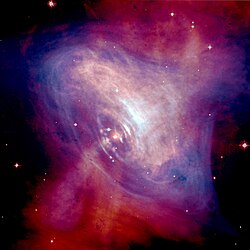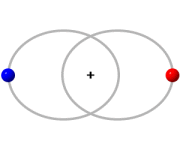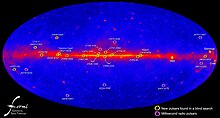Khác biệt giữa bản sửa đổi của “Sao xung”
| Dòng 20: | Dòng 20: | ||
==Danh sách các sao xung đã quan sát được== |
==Danh sách các sao xung đã quan sát được== |
||
[[Image:Fermi's Gamma-ray Pulsars.jpg|thumb|Gamma-ray pulsars detected by the Fermi Gamma-ray Space Telescope.]] |
|||
{{Đang dịch 2 (nguồn)|ngày=16 |
|||
|tháng=12 |
|||
|năm=2009 |
|||
|1 = Tiếng Anh |
|||
}} |
|||
*The first radio pulsar [[CP 1919]] (now known as [[PSR 1919+21]]), with a pulse period of 1.337 seconds and a pulse width of 0.04 second, was discovered in 1967.<ref>Hewish, A. ''et al.'' "[http://www.nature.com/physics/looking-back/hewish/index.html Observation of a Rapidly Pulsating Radio Source]." ''Nature'', Volume 217, 1968 (pages 709-713).</ref> A drawing of this pulsar's radio waves was used as the cover of British [[post-punk]] band [[Joy Division]]'s debut album, ''[[Unknown Pleasures]]''. |
|||
*The first [[binary pulsar]], [[PSR 1913+16]], whose orbit is decaying at the exact rate predicted due to the emission of [[gravitational radiation]] by [[general relativity]] |
|||
*The first millisecond pulsar, [[PSR B1937+21]] |
|||
*The brightest millisecond pulsar, [[PSR J0437-4715]] |
|||
*The first X-ray pulsar, [[Cen X-3]] |
|||
*The first accreting millisecond X-ray pulsar, [[SAX J1808.4-3658]] |
|||
*The first pulsar with planets, [[PSR B1257+12]] |
|||
*The first double pulsar binary system, [[PSR J0737-3039|PSR J0737−3039]] |
|||
*The longest period pulsar, [[PSR J2144-3933]] |
|||
*The most stable pulsar in period, [[PSR J0437-4715]] |
|||
*The magnetar [[SGR 1806-20]] produced the largest burst of power in the Galaxy ever experimentally recorded on 27 December 2004<ref>"[http://antwrp.gsfc.nasa.gov/apod/ap050221.html Galactic Magnetar Throws Giant Flare]." ''Astronomy Picture of the Day,'' 21 February 2005.</ref> |
|||
*PSR B1931+24 "... appears as a normal pulsar for about a week and then 'switches off' for about one month before emitting pulses again. [..] this pulsar slows down more rapidly when the pulsar is on than when it is off. [.. the] braking mechanism must be related to the radio emission and the processes creating it and the additional slow-down can be explained by the [[pulsar wind]] leaving the pulsar's magnetosphere and carrying away rotational energy.<ref>"[http://www.pparc.ac.uk/Nw/rel241.asp Part-Time Pulsar Yields New Insight Into Inner Workings of Cosmic Clocks]." Particle Physics and Astronomy Research Council, 3 March 2006.</ref> |
|||
*[[PSR J1748-2446ad]], at 716 Hz, the pulsar with the highest rotation speed. |
|||
*[[PSR J0108-1431]], the closest known pulsar to the Earth. It lies in the direction of the constellation [[Cetus (constellation)|Cetus]], at a distance of about 85 [[parsec]]s (280 [[light year]]s). Nevertheless, it was not discovered until 1993 due to its extremely low luminosity. It was discovered by the Danish astronomer Thomas Tauris.<ref>Tauris, T. M. ''et al.'' "[http://ucp.uchicago.edu/cgi-bin/resolve?id=doi:10.1086/187391 Discovery of PSR J0108-1431: The Closest Known Neutron Star]?" ''Astrophysical Journal,'' Volume 428, 1994 (page L53).</ref> in collaboration with a team of Australian and European astronomers using the Parkes 64-meter radio telescope. The pulsar is 1000 times weaker than an average radio pulsar and thus this pulsar may represent the tip of an iceberg of a population of more than half a million such dim pulsars crowding our Milky Way.<ref>Crowsell, K. "[http://www.newscientist.com/article/mg14219302.600-science-dim-pulsars-may-crowd-our-galaxy-.html Science: Dim Pulsars May Crowd Our Galaxy]." ''New Scientist,'' Number 1930, 18 June 2008. (page 16).</ref><ref>"[http://pqasb.pqarchiver.com/skyandtelescope/results.html?st=advanced&QryTxt=Closest+Pulsar&type=current&sortby=REVERSE_CHRON&datetype=6&frommonth=10&fromday=1&fromyear=1994&tomonth=10&today=28&toyear=1994&By=&Title=&publications=ALL Closest Pulsar]?" ''Sky & Telescope,'' October 1994 (page 14).</ref> |
|||
*[[PSR J1903+0327]], a ~2.15 ms pulsar discovered to be in a highly eccentric [[binary star]] system with a sun-like star.<ref>Champion, David J. ''et al.'' "[http://www.sciencemag.org/cgi/content/abstract/1157580 An Eccentric Binary Millisecond Pulsar in the Galactic Plane]." ''Science,'' 6 June 2008 Volume 320, Number 5881 (pages 1309-1312).</ref> |
|||
* A pulsar in the CTA 1 [[supernova]] remnant (4U 0000+72, in [[Cassiopeia (constellation)|Cassiopeia]]) was found by the [[Fermi Gamma-ray Space Telescope]] to emit pulsations only in gamma ray radiation, the first of its kind.<ref name=Atkinson/> |
|||
==Ứng dụng== |
==Ứng dụng== |
||
Phiên bản lúc 02:15, ngày 16 tháng 12 năm 2009


Sao xung (hay pulsar) là các sao neutron xoay rất nhanh, nó biểu hiện như một nguồn sóng radio, được phát ra đều đặn ở các chu kì ngắn. Cường độ bức xạ thay đổi theo một chu kì đều, điều này chỉ ra chuyển động xoay của ngôi sao. Sao Neutron xoay nhanh đến mức lực li tâm làm biến dạng bức xạ của sao thành hình nón đôi, với đỉnh chung ở tâm sao. Bức xạ hình nón này xoay tròn và chỉ quét qua một phần không gian vũ trụ, bởi thế không phải sao pulsar nào cũng thấy được, kể cả khi nó ở rất gần Trái Đất.
Lịch sử nghiên cứu

Sao xung lần đầu tiên được Jocelyn Bell Burnell và Antony Hewish của Đại học Cambridge phát hiện năm 1967 qua bức xạ radio, về sau còn có các sao xung phát ra tia X và tia gamma được khám phá. Nhờ thành công này Antony Hewish được tặng giải Nobel vào năm 1974. Họ thu được những sóng radio đặc biệt, bao gồm những dao động đồng dạng có chu kỳ đều từ vài phần nghìn đến vài giây. Giả thiết đầu tiên họ đặt ra là những sóng này đến từ những nền văn minh ngoài trái đất. Ngày nay giới khoa học thiên về công nhận giả thiết giải thích sự đều đặn của sóng radio là do được phát ra từ một ngôi sao nhiễm từ rất bé và quay rất nhanh. Để một ngôi sao có thể quay nhanh đến như thế mà không bị lực ly tâm làm tan rã, nó phải rất đặc mà đó là tích chất đặc trưng của sao neutron.
Sự phát sóng radio cực mạnh làm suy yếu năng lượng của sao xung làm cho tốc độ quay của nó chậm lại. Trong số này có sao xung Con Cua trong tinh vân Con Cua, tốc độ quay giảm một phần mười triệu mỗi năm. Trong các hệ sao đôi, sao xung hút dần vật chất từ sao đồng hành để duy trì năng lượng này.
Các loại sao xung

Cho đến nay có 3 loại sao xung được biết, phân loại theo nguồn gốc năng lượng phát ra sóng vô tuyến:
- Sao xung có năng lượng biến đổi, năng lượng mất mát này làm phát sinh ra sóng vô tuyến.
- Sao xung tích tụ năng lượng (gồm phần lớn nhưng không phải tất cả các sao xung phát ra tia X), khi năng lượng của trường hấp dẫn tăng lên đồng thời với vật chất tạo nên nguồn năng lượng (sản sinh ra tia X mà trên Trái đất có thể nhận được).
- Sao từ, ở những nơi từ trường bị suy yếu, phát sinh ra sóng vô tuyến.
Mặc dù cả 3 loại sao trên là sao neutron, nhưng chúng có trạng thái và các tính chất vật lý tương đối khác nhau. Tuy nhiên chúng cũng có mối liên hệ với nhau. Chẳng hạn, các sao xung phát ra tia X là các sao xung có năng lượng thay đổi đã về già và mất gần hết năng lượng, và chỉ nhận biết được khi cặp sao đồng hành mở rộng ra và chuyển vật chất về phía sao xung. Quá trình này tiếp tục phát triển sẽ chuyển đủ mômen động lượng đến sao xung để "tái chế" nó thành sao xung có năng lượng biến đổi một phần nghìn giây.
Danh sách các sao xung đã quan sát được

Bài viết này là công việc biên dịch đang được tiến hành từ bài viết Tiếng Anh từ một ngôn ngữ khác sang tiếng Việt. Bạn có thể giúp Wikipedia bằng cách hỗ trợ dịch và trau chuốt lối hành văn tiếng Việt theo cẩm nang của Wikipedia. |
- The first radio pulsar CP 1919 (now known as PSR 1919+21), with a pulse period of 1.337 seconds and a pulse width of 0.04 second, was discovered in 1967.[1] A drawing of this pulsar's radio waves was used as the cover of British post-punk band Joy Division's debut album, Unknown Pleasures.
- The first binary pulsar, PSR 1913+16, whose orbit is decaying at the exact rate predicted due to the emission of gravitational radiation by general relativity
- The first millisecond pulsar, PSR B1937+21
- The brightest millisecond pulsar, PSR J0437-4715
- The first X-ray pulsar, Cen X-3
- The first accreting millisecond X-ray pulsar, SAX J1808.4-3658
- The first pulsar with planets, PSR B1257+12
- The first double pulsar binary system, PSR J0737−3039
- The longest period pulsar, PSR J2144-3933
- The most stable pulsar in period, PSR J0437-4715
- The magnetar SGR 1806-20 produced the largest burst of power in the Galaxy ever experimentally recorded on 27 December 2004[2]
- PSR B1931+24 "... appears as a normal pulsar for about a week and then 'switches off' for about one month before emitting pulses again. [..] this pulsar slows down more rapidly when the pulsar is on than when it is off. [.. the] braking mechanism must be related to the radio emission and the processes creating it and the additional slow-down can be explained by the pulsar wind leaving the pulsar's magnetosphere and carrying away rotational energy.[3]
- PSR J1748-2446ad, at 716 Hz, the pulsar with the highest rotation speed.
- PSR J0108-1431, the closest known pulsar to the Earth. It lies in the direction of the constellation Cetus, at a distance of about 85 parsecs (280 light years). Nevertheless, it was not discovered until 1993 due to its extremely low luminosity. It was discovered by the Danish astronomer Thomas Tauris.[4] in collaboration with a team of Australian and European astronomers using the Parkes 64-meter radio telescope. The pulsar is 1000 times weaker than an average radio pulsar and thus this pulsar may represent the tip of an iceberg of a population of more than half a million such dim pulsars crowding our Milky Way.[5][6]
- PSR J1903+0327, a ~2.15 ms pulsar discovered to be in a highly eccentric binary star system with a sun-like star.[7]
- A pulsar in the CTA 1 supernova remnant (4U 0000+72, in Cassiopeia) was found by the Fermi Gamma-ray Space Telescope to emit pulsations only in gamma ray radiation, the first of its kind.[8]
Ứng dụng
Nghiên cứu các pulsar có nhiều ứng dụng trong vật lý và thiên văn học. Một ví dụ nổi bật là việc chứng minh sự tồn tại của bức xạ hấp dẫn được dự đoán bởi thuyết tương đối tổng quát.
Xem thêm
- Chuẩn tinh
- Sao neutron
- Sao vô tuyến
- Sao phát tia X (tiếng Anh: X-ray pulsar)
- Sao từ
- Sao một phần nghìn giây (tiếng Anh: millisecond pulsar)
Liên kết ngoài
| Wikimedia Commons có thêm hình ảnh và phương tiện truyền tải về Sao xung. |
- ^ Hewish, A. et al. "Observation of a Rapidly Pulsating Radio Source." Nature, Volume 217, 1968 (pages 709-713).
- ^ "Galactic Magnetar Throws Giant Flare." Astronomy Picture of the Day, 21 February 2005.
- ^ "Part-Time Pulsar Yields New Insight Into Inner Workings of Cosmic Clocks." Particle Physics and Astronomy Research Council, 3 March 2006.
- ^ Tauris, T. M. et al. "Discovery of PSR J0108-1431: The Closest Known Neutron Star?" Astrophysical Journal, Volume 428, 1994 (page L53).
- ^ Crowsell, K. "Science: Dim Pulsars May Crowd Our Galaxy." New Scientist, Number 1930, 18 June 2008. (page 16).
- ^ "Closest Pulsar?" Sky & Telescope, October 1994 (page 14).
- ^ Champion, David J. et al. "An Eccentric Binary Millisecond Pulsar in the Galactic Plane." Science, 6 June 2008 Volume 320, Number 5881 (pages 1309-1312).
- ^ Lỗi chú thích: Thẻ
<ref>sai; không có nội dung trong thẻ ref có tênAtkinson
